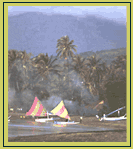 Green Bali is the eco-tourist’s playground of green jungle thrills and spectacular waterfall spills. Bali parks, jungles and hills are home to a host of wildlife, which includes monkeys, civets, mousedeer, barking deer and flocks of gaily-feathered beauties like the endemic Bali starling, dollar birds, wild fowl, sea eagles, sandpipers, blue kingfishers, white herons and egrets, sparrows, cuckoos and wood swallows.
Green Bali is the eco-tourist’s playground of green jungle thrills and spectacular waterfall spills. Bali parks, jungles and hills are home to a host of wildlife, which includes monkeys, civets, mousedeer, barking deer and flocks of gaily-feathered beauties like the endemic Bali starling, dollar birds, wild fowl, sea eagles, sandpipers, blue kingfishers, white herons and egrets, sparrows, cuckoos and wood swallows.
|
Bali’s bag of goodies for the nature inclined are the many beautiful shades and hues of greens of its wildlife forests and parks, which include the Ubud Monkey Forest, Sangeh Monkey Forest, Bali Elephant Park in Central Bali, Bali Bird Park in Singapadu, and Bali Butterfly Park.Have a splashing time at Bali’s numerous waterfalls, from the Gitgit Falls, Blahmantung Falls, and Singsing Falls, to the cool pools of Yeh Sanih and the soothingly hot springs of Banjar. Soak up on refreshing jungle sights and smells at Bali’s rich national park and botanical gardens; and drink in the splendour of its ancient mounts and volcanoes.
So, if natural greens are your favourite hues, come on round to Bali and have some fun in Mother Nature’s very own theme park! |
| Ubud Monkey Forest is an amazing place to be and an extremely rewarding experience. Watch friendly and mischievous monkeys doing their thing in their own habitat, and watch them watching you doing your thing in their habitat! It definitely is sheer fun to see these intelligent creatures observing us trying to figure out their hierarchy.Ubud Monkey Forest is located in Ubud, Central Bali, and pleasantly laid out along two roads; thus affording hours of leisurely roaming around without the hassle of getting lost. This monkey forest is rather smaller than the Sangeh Monkey Forest, but its star attractions come with just as much fun.
Found to the south of Monkey Forest Road, this small beautiful forest is home to a band of grey monkeys, but their immediate number still remains unknown. The main tourist hangout is about a hundred metres from the entrance. Most visitors rarely venture much farther out than this, as this area is the place to be, with lots of monkeys, people and their resulting antics to enjoy. The monkeys will know that visitors have a treat or two for them, but it is the big males which usually prevail for the bananas; and it is not wise to try to pet the monkeys as they are natural and wild. Monkeys aside, the Ubud Monkey Forest is indeed a lovely and relaxing place to be. Take for instance the interesting path beside a great banyan tree to the right of the entrance, meandering down to a charming bathing temple surrounded by lush remnants of the dipterocarp forest. Just off the main square is a lovely arched stone bridge leading to the forest’s most alluring feature – the Hindu elephant-headed Lord Ganesh sitting comfortably overlooking a small, square, moss-covered pool where several koi swim at his feet! The Sangeh Monkey Forest near the village of Sangeh, in south western Bali, is 6 hectares of renowned forested land of giant nutmeg trees, doubling as homes to hordes of sacred monkeys in the forest. The monkeys here inhabit both the trees and the Pura Bukit Sari, a temple deep within the fragrant greens. |
| Bali’s majestic Indonesian Elephants can be found in the Bali Elephant Safari Park of Desa Taro, north of Ubud. This park offers visitors a chance to get up close and personal with the peaceful giants and also go for a sight-seeing expedition towering on the backs of these peaceful creatures. |
| The Bali Butterfly Park in Tabanan is the island’s sole butterfly enclosure. The park has acres of charming grounds and intricately landscaped gardens, making it a fitting home to the many flying colours. This place is definitely worth a visit. The Bali Bird Park in Batubulan, meanwhile, has over a thousand feathered beauties which include nearly every rare and varied species in the whole of Indonesia. Do take note of the bird park’s beautifully landscaped grounds. |
| The cascading Gitgit Waterfalls in the south of Singaraja, is a spectacular 40 metres of crystal clear cool liquid, rushing headlong into a seemingly bottomless pool of cool refreshment. This alluring pool carries a tale of its own which can only be unlocked by a visit.The Blahmantung Waterfalls in Pupuan takes quite a walk to reach but is really worth the effort. The Air Terjun Singsing west of Lovina, actually means Daybreak Waterfall, and truly gushes will all the possibilities and strength of a refreshing brand new day.
Another spot well known for its waters are the pools of Yeh Sanih. The attractions here are actually freshwater springs channelled into clean and tempting swimming pools, amid charming garden surroundings. The steaming Hot Springs of Banjar are also definitely worth a few days of heavenly soaking. It is also conveniently close to the Brahmavihara Arama in Banjar, Bali’s only Buddhist monastery, with a handsome structure offering inspiring views of land and sky meeting sea. |
| It is truly a treat to be able to wander freely around the Bali Botanical Gardens in Bedugul, deep in the heart of northern Bali. Established in 1959, it is a never ending 120 hectares, high on the slopes of Tree Mountain; with a massive collection of trees; and half a thousand species of exotic orchids!Western Bali’s Taman Nasional Bali Barat is a conservation park spread over almost the whole of the island’s western tip. It is bordered by open savannahs, dense rainforests, tangles of mangrove swamps, and the colourful coral reefs of the renowned Deer Island, locally called Pulau Menjangan, habitat of the rare Java Deer. |
| Bali’s ancient and rugged landscape is well represented by the Danau Batur, also known as the Gunung Batur area. The volcanic cones of Gunung Batur are located in inspiringly massive bowl-shaped calderas. The majestic Gunung Batur rises to a towering 1717 metres, and remains one of Bali’s natural wonders. Iit really does make for perfect trekking for the eco-minded. But the island’s ultimate trekking hurdle is called Gunung Agung. Also |  |
| Bali’s highest and most revered mount, it is not difficult to climb, although it does turn into quite a workout. Remember to start really early – a few hours before sunrise. The dry season of April till October will always be the best time to conquer Mount Agung, but make sure that your date of challenge does not coincide with any festivals held at Bali’s Mother Temple, Pura Besakih, high on the slopes of this imposing beauty. |
















